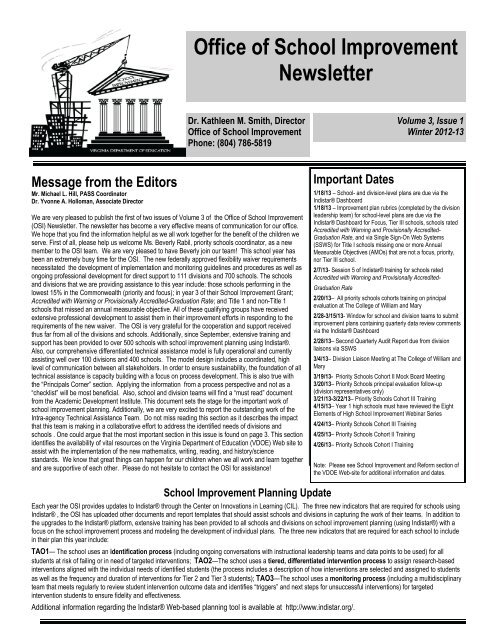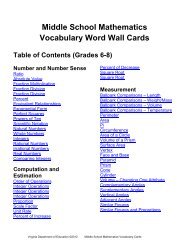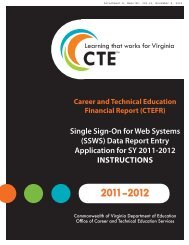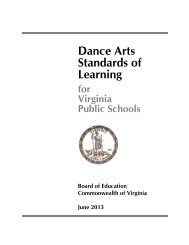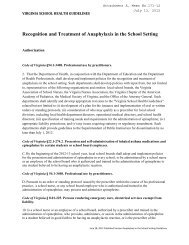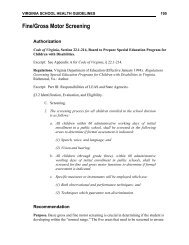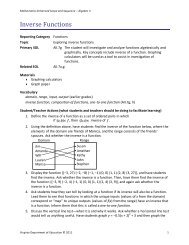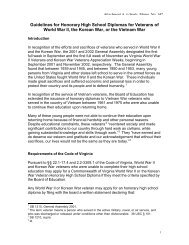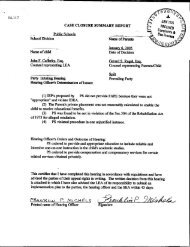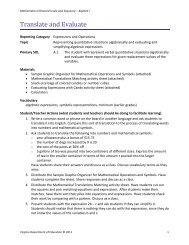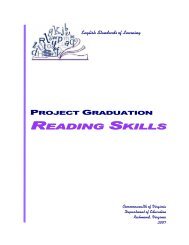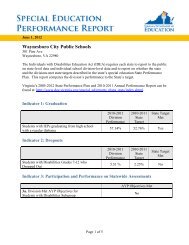Winter 2013 - Virginia Department of Education
Winter 2013 - Virginia Department of Education
Winter 2013 - Virginia Department of Education
Create successful ePaper yourself
Turn your PDF publications into a flip-book with our unique Google optimized e-Paper software.
Office <strong>of</strong> School Improvement<br />
Newsletter<br />
Dr. Kathleen M. Smith, Director<br />
Office <strong>of</strong> School Improvement<br />
Phone: (804) 786-5819<br />
Volume 3, Issue 1<br />
<strong>Winter</strong> 2012-13<br />
Message from the Editors<br />
Mr. Michael L. Hill, PASS Coordinator<br />
Dr. Yvonne A. Holloman, Associate Director<br />
We are very pleased to publish the first <strong>of</strong> two issues <strong>of</strong> Volume 3 <strong>of</strong> the Office <strong>of</strong> School Improvement<br />
(OSI) Newsletter. The newsletter has become a very effective means <strong>of</strong> communication for our <strong>of</strong>fice.<br />
We hope that you find the information helpful as we all work together for the benefit <strong>of</strong> the children we<br />
serve. First <strong>of</strong> all, please help us welcome Ms. Beverly Rabil, priority schools coordinator, as a new<br />
member to the OSI team. We are very pleased to have Beverly join our team! This school year has<br />
been an extremely busy time for the OSI. The new federally approved flexibility waiver requirements<br />
necessitated the development <strong>of</strong> implementation and monitoring guidelines and procedures as well as<br />
ongoing pr<strong>of</strong>essional development for direct support to 111 divisions and 700 schools. The schools<br />
and divisions that we are providing assistance to this year include: those schools performing in the<br />
lowest 15% in the Commonwealth (priority and focus); in year 3 <strong>of</strong> their School Improvement Grant;<br />
Accredited with Warning or Provisionally Accredited-Graduation Rate; and Title 1 and non-Title 1<br />
schools that missed an annual measurable objective. All <strong>of</strong> these qualifying groups have received<br />
extensive pr<strong>of</strong>essional development to assist them in their improvement efforts in responding to the<br />
requirements <strong>of</strong> the new waiver. The OSI is very grateful for the cooperation and support received<br />
thus far from all <strong>of</strong> the divisions and schools. Additionally, since September, extensive training and<br />
support has been provided to over 500 schools with school improvement planning using Indistar®.<br />
Also, our comprehensive differentiated technical assistance model is fully operational and currently<br />
assisting well over 100 divisions and 400 schools. The model design includes a coordinated, high<br />
level <strong>of</strong> communication between all stakeholders. In order to ensure sustainability, the foundation <strong>of</strong> all<br />
technical assistance is capacity building with a focus on process development. This is also true with<br />
the “Principals Corner” section. Applying the information from a process perspective and not as a<br />
“checklist” will be most beneficial. Also, school and division teams will find a “must read” document<br />
from the Academic Development Institute. This document sets the stage for the important work <strong>of</strong><br />
school improvement planning. Additionally, we are very excited to report the outstanding work <strong>of</strong> the<br />
Intra-agency Technical Assistance Team. Do not miss reading this section as it describes the impact<br />
that this team is making in a collaborative effort to address the identified needs <strong>of</strong> divisions and<br />
schools . One could argue that the most important section in this issue is found on page 3. This section<br />
identifies the availability <strong>of</strong> vital resources on the <strong>Virginia</strong> <strong>Department</strong> <strong>of</strong> <strong>Education</strong> (VDOE) Web site to<br />
assist with the implementation <strong>of</strong> the new mathematics, writing, reading, and history/science<br />
standards. We know that great things can happen for our children when we all work and learn together<br />
and are supportive <strong>of</strong> each other. Please do not hesitate to contact the OSI for assistance!<br />
Important Dates<br />
1/18/13 – School- and division-level plans are due via the<br />
Indistar® Dashboard<br />
1/18/13 – Improvement plan rubrics (completed by the division<br />
leadership team) for school-level plans are due via the<br />
Indistar® Dashboard for Focus, Tier III schools, schools rated<br />
Accredited with Warning and Provisionally Accredited-<br />
Graduation Rate, and via Single Sign-On Web Systems<br />
(SSWS) for Title I schools missing one or more Annual<br />
Measurable Objectives (AMOs) that are not a focus, priority,<br />
nor Tier III school.<br />
2/7/13- Session 5 <strong>of</strong> Indistar® training for schools rated<br />
Accredited with Warning and Provisionally Accredited-<br />
Graduation Rate<br />
2/20/13– All priority schools cohorts training on principal<br />
evaluation at The College <strong>of</strong> William and Mary<br />
2/28-3/15/13- Window for school and division teams to submit<br />
improvement plans containing quarterly data review comments<br />
via the Indistar® Dashboard<br />
2/28/13– Second Quarterly Audit Report due from division<br />
liaisons via SSWS<br />
3/4/13– Division Liaison Meeting at The College <strong>of</strong> William and<br />
Mary<br />
3/19/13- Priority Schools Cohort II Mock Board Meeting<br />
3/20/13– Priority Schools principal evaluation follow-up<br />
(division representatives only)<br />
3/21/13-3/22/13– Priority Schools Cohort III Training<br />
4/15/13– Year 1 high schools must have reviewed the Eight<br />
Elements <strong>of</strong> High School Improvement Webinar Series<br />
4/24/13– Priority Schools Cohort III Training<br />
4/25/13– Priority Schools Cohort II Training<br />
4/26/13– Priority Schools Cohort I Training<br />
Note: Please see School Improvement and Reform section <strong>of</strong><br />
the VDOE Web-site for additional information and dates.<br />
School Improvement Planning Update<br />
Each year the OSI provides updates to Indistar® through the Center on Innovations in Learning (CIL). The three new indicators that are required for schools using<br />
Indistar® , the OSI has uploaded other documents and report templates that should assist schools and divisions in capturing the work <strong>of</strong> their teams. In addition to<br />
the upgrades to the Indistar® platform, extensive training has been provided to all schools and divisions on school improvement planning (using Indistar®) with a<br />
focus on the school improvement process and modeling the development <strong>of</strong> individual plans. The three new indicators that are required for each school to include<br />
in their plan this year include:<br />
TAO1— The school uses an identification process (including ongoing conversations with instructional leadership teams and data points to be used) for all<br />
students at risk <strong>of</strong> failing or in need <strong>of</strong> targeted interventions; TAO2—The school uses a tiered, differentiated intervention process to assign research-based<br />
interventions aligned with the individual needs <strong>of</strong> identified students (the process includes a description <strong>of</strong> how interventions are selected and assigned to students<br />
as well as the frequency and duration <strong>of</strong> interventions for Tier 2 and Tier 3 students); TAO3—The school uses a monitoring process (including a multidisciplinary<br />
team that meets regularly to review student intervention outcome data and identifies “triggers” and next steps for unsuccessful interventions) for targeted<br />
intervention students to ensure fidelity and effectiveness.<br />
Additional information regarding the Indistar® Web-based planning tool is available at http://www.indistar.org/.
Office <strong>of</strong> School Improvement (OSI) Updates<br />
Focus and Tier III Schools<br />
Per the Elementary and Secondary <strong>Education</strong><br />
Act <strong>of</strong> 1965 (ESEA) flexibility waiver, Title I<br />
schools with one or more pr<strong>of</strong>iciency gap<br />
groups not meeting performance expectations<br />
in reading and mathematics were identified for<br />
inclusion in the focus school category.<br />
Gap Group 1: Students with Disabilities, English<br />
Language Learners (ELL, and Economically<br />
Disadvantaged (unduplicated))<br />
Gap Group 2: Black students, not <strong>of</strong> Hispanic<br />
origin, including Students with Disabilities, ELL,<br />
and Economically Disadvantaged Students<br />
Gap Group 3:Hispanic students, <strong>of</strong> one or more<br />
Races, including Students with Disabilities, ELL,<br />
And Economically Disadvantaged Students<br />
Title I schools with one <strong>of</strong> more pr<strong>of</strong>iciency<br />
gap groups failing to meet the 95 percent<br />
participation rate in reading and/or<br />
mathematics were also considered for<br />
inclusion in the focus school category. There<br />
are currently 72 focus schools representing 48<br />
local educational agencies. On September<br />
17-18, 2012, the OSI hosted a conference for<br />
principals and division contact persons<br />
associated with identified focus schools.<br />
During the conference, participants received<br />
information regarding the requirements for<br />
school improvement planning, OSI technical<br />
assistance opportunities, targeted intervention<br />
strategies for students, contractor will work<br />
with the division leadership team to provide<br />
intensive support to focus school principals<br />
and their staff members. In addition, the<br />
Differentiated Technical Assistance Team<br />
(DTAT) will support these schools through<br />
webinars and/or on-site assistance. Please<br />
see the School Improvement and Reform<br />
page <strong>of</strong> the VDOE Web site for more<br />
information<br />
(http://www.doe.virginia.gov/support/school_i<br />
mprovement/index.shtml).<br />
Priority Schools<br />
All priority schools participated in schools<br />
improvement pr<strong>of</strong>essional development in<br />
January. Cohort I schools are presently<br />
developing sustainability plans for exit or<br />
continuation with reduced funding. In January,<br />
division and school teams reflected on<br />
structures and processes that have supported<br />
improvement efforts and led to increased<br />
student achievement. School and division<br />
teams will focus on documenting specific<br />
plans for sustaining and continuing improvement<br />
in the school’s plan on Indistar® in<br />
preparation for the April phase out training.<br />
Cohort II schools are focusing on student<br />
engagement and teacher observation and<br />
feedback. During the training, participants<br />
visited three classrooms and conducted<br />
observations using student engagement<br />
and teacher observation tools developed as<br />
a part <strong>of</strong> the School-University Research<br />
Network (SURN) Principal Academy. Observation<br />
data were shared and analyzed<br />
with a focus on high-yield strategies. Administrators<br />
role-played giving specific feedback.<br />
A special thank you to Prince Edward<br />
County Public Schools for hosting Cohort II<br />
in their schools for the observations. March<br />
training will be “Mock Board Meeting” presentations<br />
by each school. Cohort III schools<br />
continued a review and discussion <strong>of</strong> transformational<br />
toolkit indicators to be assessed.<br />
Building Autonomy (Strand B) and<br />
Leading Change (Strand G) were the objectives<br />
for this session. Participants discussed<br />
school autonomy and resource<br />
alignment, created sample organizational<br />
charts, shared quick wins, discussed strategies<br />
to communicate change and accountability<br />
with stakeholders, created and<br />
shared lists noting all types <strong>of</strong> data meetings<br />
held in their schools and shared hurdles<br />
they have encountered. March training<br />
will focus on Working with Stakeholders<br />
and Building Support for Transformation<br />
(Strand D); Providing Rigorous Staff Development<br />
(Strand I); and Reforming Instruction<br />
(Strand K.)<br />
Schools Rated Accredited with Warning<br />
and Provisionally Accredited –<br />
Graduation Rate<br />
Schools rated Accredited with Warning and<br />
Provisionally Accredited-Graduation Rate<br />
have made great strides in school improvement<br />
planning and implementation.<br />
Schools have selected and are implementing<br />
an Early Warning System such as<br />
VEWS or DataCation to assist them with<br />
intervention planning, implementation, and<br />
monitoring. Schools have completed four<br />
out <strong>of</strong> five Indistar® training sessions with<br />
Dr. Yvonne Holloman, and are progressing<br />
well with indicator identification and task<br />
development. Twenty-eight (28) schools in<br />
their first year rated Accredited with Warning<br />
or Provisionally Accredited– Graduation<br />
Rate have participated in on-site reviews; the<br />
remaining 42 reviews will be completed in<br />
January and February. On December4, 18<br />
school principals participated in Breaking<br />
Ranks in the Middle (BRIM) training sponsored<br />
by OSI in conjunction with the <strong>Virginia</strong><br />
Foundation for <strong>Education</strong>al Leadership<br />
(VFEL). Thirteen middle schools have received<br />
an OSI-sponsored grant to participate<br />
in the TenMarks® Math Pilot project, which<br />
kicks <strong>of</strong>f this month.<br />
Title I and Non-Title 1 Schools Missing<br />
One or more AMOs and that are fully<br />
accredited and neither Focus, Priority,<br />
nor Tier III Schools<br />
These schools have been working on required<br />
school improvement plans. Title I schools are<br />
required to use Indistar® to create the school<br />
improvement plan; non-Title I schools may<br />
elect to use Indistar® on a voluntary basis.<br />
Technical assistance has been provided by<br />
division liaisons and by additional contractors<br />
for those schools without division liaisons.<br />
Differentiated Technical Assistance<br />
Team (DTAT)<br />
The OSI provides direct technical assistance<br />
to divisions and schools through the DTAT.<br />
Members <strong>of</strong> this team are retired educators<br />
and/or education consultants that are experts<br />
in one or more areas <strong>of</strong> technical assistance.<br />
This team <strong>of</strong> contractors works collaboratively<br />
with other VDOE contractors and division staff<br />
to help ensure a high level <strong>of</strong> communication<br />
between all stakeholders. As indicated earlier<br />
on page 1, during the first semester DTAT has<br />
provided support to over 100 divisions and<br />
400 schools. New for this year is a dedicated<br />
e-mail address for DTAT,<br />
osita@doe.virginia.gov. Please use this e-<br />
mail address when requesting support from<br />
DTAT.<br />
2
<strong>Virginia</strong> <strong>Department</strong> <strong>of</strong> <strong>Education</strong><br />
Intra-agency Technical Assistance Team and<br />
Teacher Specific Available Resources<br />
The <strong>Virginia</strong> <strong>Department</strong> <strong>of</strong> <strong>Education</strong> (VDOE) Intra-agency Technical Assistance Team serves as an important arm <strong>of</strong> the<br />
VDOE Statewide System <strong>of</strong> Support. The primary role <strong>of</strong> the team is to assist the OSI with responding to identified technical assistance needs for<br />
divisions and schools. Technical assistance needs are supported through a coordinated, differentiated, individualized technical assistance<br />
approach. In addition, the team meets several times throughout the year sharing information about resources and technical assistance to better<br />
coordinate support from the VDOE. Currently, team participation is at an all-time high with 20 active members representing nine VDOE<br />
departments/<strong>of</strong>fices. Team meetings are focused on building VDOE capacity with collaborative and passionate student-centered discussions. The<br />
OSI is very appreciative <strong>of</strong> the dedication and support that has been received as a result <strong>of</strong> the Intra-agency Technical Assistance Team. Team<br />
members include:<br />
Mr. Michael Bolling, Director, Mathematics and Governor’s Schools<br />
Ms. Jo Ann Burkholder, Student Assistance Systems Coordinator, OSI<br />
Dr. Cynthia Cave, Director, Office <strong>of</strong> Student Services<br />
Mr. Jason Ellis, Test Results Utilization, Testing Administration, Scoring & Reporting<br />
Dr. Susan FitzPatrick, Grants and Program Manager, OSI<br />
Ms. Stacy Freeman, Title III ESL Specialist, PAA<br />
Mr. Michael Hill, The Partnership for Achieving Successful Schools (PASS) Coordinator, OSI, (Team Chairperson)<br />
Dr. Yvonne Holloman, Division Level Support Coordinator, OSI<br />
Dr. Teresa Lee, Specialist-Learning Disabilities and Attention Disorders, Special <strong>Education</strong> Instructional Services<br />
Dr. Thomas Manthey, Specialist – Adolescent Literacy, Special <strong>Education</strong> Instructional Service<br />
Ms. Rebecca Marable, Title I Coordinator, PAA<br />
Mr. Eric Rhoades, Director, Science and Health <strong>Education</strong><br />
Ms. Tracy Robertson, English Coordinator, Humanities and Early Childhood<br />
Mr. Thomas Santangelo, English/Reading Elementary, Humanities and Early Childhood<br />
Ms. Amy Siepka, Assessment Development Coordinator, Assessment Development<br />
Dr. Lynn Sodat, Improvement Specialist, OSI<br />
Dr. Kathleen Smith, Director, Office <strong>of</strong> School Improvement<br />
Dr. Vivian Stith-Williams, Student Services Specialist<br />
Ms. Carol Sylvester, Title II, PAA<br />
Dr. Linda Wallinger, Assistant Superintendent for Instruction<br />
Dr. Deborah Wickham, Mathematics - Mathematics—Elementary and Governor’s Schools<br />
Important VDOE Resources<br />
The VDOE provides a variety <strong>of</strong> resources for local educational agencies (LEAs) to use in preparation for the <strong>Virginia</strong> Standards <strong>of</strong> Learning (SOL)<br />
assessments.<br />
SOL practice items -<br />
Provide examples <strong>of</strong> the new content and increased rigor represented by the revised SOL and illustrate the new Technology-Enhanced Item<br />
types for the mathematics, reading, science, and writing SOL tests.<br />
May be found at the following link: http://www.doe.virginia.gov/index.shtml<br />
SOL practice items resource page includes -<br />
Practice items for mathematics, English, and science SOL assessments<br />
Audio version <strong>of</strong> practice items for students with accommodation for testing (Individual <strong>Education</strong> Plan and Section 504 Plans)<br />
Practice item guides<br />
TeacherDirect -<br />
Provides a way to share new instructional resources created by VDOE staff as well as make teachers aware <strong>of</strong> pr<strong>of</strong>essional<br />
development and grant opportunities, and other information <strong>of</strong> special interest to teachers and their students. This is an awesome resource<br />
for classroom teachers!<br />
The TeacherDirect resources may be found at the following link: http://www.doe.virginia.gov/testing/teacher_direct/index.shtml. Teachers<br />
may subscribe to TeacherDirect by clicking on this link: Subscribe to TeacherDirect Weekly Updates<br />
Mathematics, English and Language Arts, and Science Updates<br />
Michael Bolling, director, Office <strong>of</strong> Mathematics and Governor’s Schools, Tracie Robertson, English coordinator, Humanities and Early<br />
Childhood, and Eric M. Rhoades, director, Office <strong>of</strong> Science and Health <strong>Education</strong> <strong>of</strong>fer regular updates for teachers and school communities.<br />
Updates are sent to respective division contacts for distribution to teachers. They <strong>of</strong>fer up to date information specific to classroom<br />
instruction. Teachers will find these updates to be extremely helpful in preparing students for SOL assessments.<br />
3
School improvement is a PROCESS not a checklist <strong>of</strong><br />
activities. Align these principal-specific actions to help<br />
drive the school improvement PROCESS in your school.<br />
Every Month<br />
>> Conduct monthly meeting with the school leadership and<br />
improvement team. (review progress <strong>of</strong> school improvement plan<br />
(SIP) on Indistar®; review current intervention data on all Tier 2<br />
and Tier 3 students (including Students with Disabilities and<br />
English Language Learners) and other school data; review school<br />
Indistar® dashboard for reports due dates; status <strong>of</strong> all technical<br />
assistance and upcoming pr<strong>of</strong>essional development; make<br />
needed revisions; post progress monitoring notes, agendas, and<br />
minutes).<br />
>> Observe classroom instruction and conduct follow-up<br />
conferences with teachers (review lesson plan to ensure planning<br />
matches what is being taught; schedule peer observations and<br />
assign pr<strong>of</strong>essional development as necessary).<br />
>> Review and monitor weekly lesson plans for all teachers—<br />
plans must include evidence <strong>of</strong> application <strong>of</strong> VDOE Web site<br />
resources for writing, English, mathematics, and science;<br />
evidence <strong>of</strong> collaborative planning with the special education<br />
teacher, if appropriate.<br />
>> Review all classroom teacher formative assessments to<br />
ensure curriculum map alignment, lesson plan alignment, and<br />
SOL test format including regular practice with technologyenhanced<br />
test items and writing SOL requirements.<br />
>> Conduct instructional walkthroughs with the school leadership<br />
team to include division personnel noting instructional areas <strong>of</strong><br />
strength and addressing areas needing improvement.<br />
>> Conduct monthly staff meeting with a focus on instructional<br />
practices; review/update <strong>of</strong> Indistar® SIP; update on all technical<br />
assistance and pr<strong>of</strong>essional development activities; update on<br />
school safety procedures/crisis plan.<br />
>> Conduct monthly administrative meeting with gradelevel/content<br />
area teams to discuss individual student progress<br />
(all students); discuss referrals to Student Intervention Team<br />
where necessary; all support staff attend to include guidance.<br />
>> Conduct principal-led parent outreach initiative to increase<br />
active involvement and communication<br />
>> Develop and distribute school monthly newsletter and<br />
calendar <strong>of</strong> activities for the upcoming month to all staff members,<br />
students, and parents.<br />
>> Maintain updated school-wide calendar showing all school<br />
related activities for the month. Post where all staff can view.<br />
Principals’ Corner<br />
January<br />
>> Review report cards providing written feedback to teachers<br />
and positive and encouraging comments to students.<br />
>> Following division procedures, develop and monitor<br />
performance improvement plans for teachers whose performance<br />
fails to meet expectations.<br />
>> Identify staff members whom you will not recommend for<br />
contract renewal. Collaborate with your immediate supervisor and<br />
the human resources department to prepare the appropriate<br />
documentation adhering to reporting timelines as directed.<br />
>> Initiate school-developed retention procedures and guidelines<br />
timeline. (Begin meetings with teachers regarding their tentative<br />
retention lists; supports needed for individual student success,<br />
and procedures for notifying parents <strong>of</strong> the possibility <strong>of</strong><br />
retention.)<br />
>> Conduct mid-year meeting with students to reinforce schoolwide<br />
academic expectations and to review the school’s Code <strong>of</strong><br />
Conduct with an emphasis on the most commonly cited<br />
infractions at the school. All staff should attend.<br />
>> Plan a quarterly school celebration for students, staff, and<br />
parents.<br />
February<br />
>> Complete quarterly report form on Indistar® dashboard.<br />
>> Meet with staff members regarding the upcoming SOL Writing<br />
Test. (Conduct meeting with grade teachers and proctors<br />
regarding testing procedures reinforcing the computer use<br />
requirement and VDOE available resources including practice<br />
level prompts; distribute parent letters and testing schedule ;<br />
develop incentive plan for students; schedule individual student<br />
conferences to provide support and build confidence.)<br />
>> Begin developing a six-week instructional plan to begin prior to<br />
spring testing with a focus on individual student needs.<br />
>> Conduct a quarterly school celebration for students, staff, and<br />
parents.<br />
March<br />
>> Finalize a six-week instructional plan targeting specific<br />
individual student needs in preparation for spring testing (to be<br />
implemented and monitored during the six weeks prior to testing).<br />
>> Plan transition program for rising sixth/ninth grade students<br />
that includes staff from elementary, middle, and high school.<br />
>> Plan a quarterly school celebration for students, staff, and<br />
parents.<br />
4
Frequently Asked Questions About the Indistar® Webbased Planning Tool<br />
Tasks/Indicators<br />
Q: How many rapid improvement school indicators should be included in a school’s plan?<br />
A: The number <strong>of</strong> indicators will vary based on the school’s status:<br />
Focus schools – Five indicators are required including the three required indicators (TA01, TA02, and TA03).<br />
Schools rated Accredited with Warning – The three required indicators (TA01, TA02, and TA03) must be included as well<br />
as any additional indicators that are aligned with the Essential Actions from the academic review report.<br />
Q: What is the process for removing specific indicators or tasks?<br />
A: Indistar® is a continuous improvement process and is not designed for indicators to be removed.<br />
When a school/division leadership team makes the decision to discontinue work with a specific indicator, then comments to<br />
this effect should be made in the Monitoring the Plan component <strong>of</strong> the Indistar® Web-based planning tool. Retaining indicators<br />
and tasks enable the school/division team to keep a historical record <strong>of</strong> all previous school improvement efforts. Please<br />
contact Dr. Yvonne Holloman (Yvonne.Holloman@doe.virginia.gov), not the Center on Innovations in Learning (CIL), to<br />
discuss any issues related to removal <strong>of</strong> indicators.<br />
Q: My school/division leadership team has completed several indicators, but they continue to be<br />
displayed as a part <strong>of</strong> the improvement plan. Will CII remove “old” indicators?<br />
A: Indistar® is premised on the concept <strong>of</strong> continuous improvement; therefore, it is imperative for all<br />
work to be displayed so that everyone is able to view the “historical record” <strong>of</strong> improvement efforts<br />
at the school- or division-level.<br />
Updating an Improvement Plan<br />
Q: May my school/division team continue our work with an indicator if all tasks have been<br />
completed?<br />
A: Yes. Your team would need to update information in the Create School Plan component <strong>of</strong> the<br />
main menu by changing the indicator’s target date and adding new tasks. You may also update<br />
your description <strong>of</strong> what the objective (indicator) will look like when it is fully implemented.<br />
Q: What is the process for editing/revising information (i.e. , tasks, dates) included in the school improvement plan?<br />
A: Any information entered into the school improvement plan may be edited/revised at any time by<br />
revisiting the Create School Plan component <strong>of</strong> the main menu, and editing the appropriate<br />
components.<br />
Q: My school/division leadership team has completed several indicators, but they continue to be<br />
displayed as a part <strong>of</strong> the improvement plan. Will CII remove “old” indicators?<br />
A: Indistar® is premised on the concept <strong>of</strong> continuous improvement; therefore, it is imperative for all<br />
work to be displayed so that everyone is able to view the “historical record” <strong>of</strong> improvement efforts<br />
at the school- or division-level.<br />
Monitoring an Improvement Plan<br />
Q: How <strong>of</strong>ten should the school team enter comments about tasks into the Monitor School Plan<br />
component <strong>of</strong> the main menu?<br />
A: In an effort to ensure that tasks are monitored in a timely manner, comments should be entered<br />
on a monthly basis.<br />
5
Frequently Asked Questions About the Indistar® Webbased Planning Tool<br />
Entering Data<br />
Q: What type <strong>of</strong> data should a school team enter into the Assessment component <strong>of</strong> the main<br />
menu?<br />
A: Formative data associated with tasks included in the improvement plan must be entered into the<br />
Assessment component <strong>of</strong> the main menu. Please do not enter benchmark or SOL data.<br />
Submitting Forms<br />
Q: One <strong>of</strong> the schools in my division has completed a form on the Indistar® Dashboard, but I am<br />
unable to view it using the division’s password. What should I do?<br />
A: Forms that are posted on a school’s dashboard will not be visible to anyone entering the Indistar®<br />
Web site using the division’s password until after the school has saved the form. Once a school has entered and saved any<br />
information in the form, the form will be visible to the division team.<br />
Q: I submitted a form on the Indistar® Dashboard by mistake. What should I do?<br />
A: The school principal should send an e-mail to Dr. Yvonne Holloman<br />
(Yvonne.Holloman@doe.virginia.gov) requesting that the “Submit” button be reset.<br />
Q: I have entered information into Indistar® for one <strong>of</strong> the schools in my division that I supervise.<br />
However, I am unable to save the information. What should I do?<br />
A: Indistar® is designed for all school-related information to originate from the school. If someone attempts to enter information<br />
using an access-level other than the school’s, then the information will not be saved or the user will be unable to enter information.<br />
A red message at the top <strong>of</strong> each page will alert the user to this restriction.<br />
2012-<strong>2013</strong> School Improvement Plan Requirements<br />
Improvement Planning Requirements<br />
Focus Schools<br />
Priority Schools<br />
Schools rated Accredited with<br />
Warning<br />
Schools rated Provisionally Accredited<br />
Title I Schools that did not meet an<br />
AMO<br />
Non‐Title I Schools that did not meet<br />
an AMO<br />
Indistar® required<br />
•Three required targeted intervention indicators required<br />
Indistar® required<br />
•Transformation Toolkit or Lead Turnaround Partner indicators<br />
required<br />
Indistar® required<br />
•Three required targeted intervention indicators required<br />
Indistar ®required<br />
•Three required targeted intervention indicators required<br />
Locally‐developed school improvement plan required<br />
6
A Different Kind <strong>of</strong> Work<br />
Academic Development Institute—Maureen Mirabito and Sam Redding<br />
Think <strong>of</strong> a time you earned something. Really earned it. Succeeded.<br />
Chances are you didn’t will success; you worked at it. Hard. You focused your time (more in some areas than in others) and your effort (a little more<br />
here, a lot more there). You started early and ended late because you had a new idea or maybe just a strong conviction for making it happen. You probably got the<br />
people around you involved and even a bit excited. They showed you a way you hadn’t thought <strong>of</strong>; you showed them that their way mattered.<br />
Success in improving districts and schools works the same way. Students learn more (and better) when people in the school focus their time and effort<br />
on elevating their specific teaching, leading, connecting, and learning skills. They work hard at it. They get others involved and excited to do the same.<br />
Soon, they are not just people in a school. They are the team <strong>of</strong> the school. Maybe the Leadership Team directs the action, but the whole school<br />
becomes a team. The performance <strong>of</strong> every player counts.<br />
Indistar® is premised on the understanding that districts and schools improve and succeed when three things are present and balanced: 1) specific<br />
expectations for pr<strong>of</strong>essional practice; 2) personal investment and engagement to improve the school (i.e. student learning); 3) a climate <strong>of</strong> candor and trust.<br />
Candor means unadorned honesty in examining the pr<strong>of</strong>essional practice <strong>of</strong> everyone. Trust is the assurance that the candor is aimed at helping everyone improve<br />
in order to achieve the best results for students.<br />
Indistar® has simplified and organized the research, translated it into clear statements <strong>of</strong> effective pr<strong>of</strong>essional practice (skills), and built a platform<br />
where school and district teams can prioritize the skills (what will have the greatest impact immediately), create action steps for making them happen (who will do<br />
what and when), and communicate progress around them (here’s what’s working, here’s where we need to do better). It doesn’t do the work <strong>of</strong> district or school<br />
improvement for you, but it makes it easier for you prioritize the work, communicate it, and stay on top <strong>of</strong> it. Considering the amount <strong>of</strong> distractions that creep up in<br />
a school day (okay, a school hour) that kind <strong>of</strong> support is critical.<br />
Skills + Indicators <strong>of</strong> Effective Practice<br />
Indistar® is built upon a specific set <strong>of</strong> practices (or skills routinely exercised) that people must elevate and apply diligently to successfully improve the<br />
school. They are called indicators <strong>of</strong> effective practice (note the indi in Indistar®). An indicator <strong>of</strong> effective practice is a concrete, behavioral expression <strong>of</strong> a<br />
pr<strong>of</strong>essional practice that contributes to student learning, supported by research. It is expressed in plain language so that a school team can answer easily and with<br />
certainty whether it is present or not present. The less gray area the better.<br />
Likened to the concept <strong>of</strong> “drilling down”—moving through a hierarchy <strong>of</strong> information from the top, downwards into levels <strong>of</strong> greater detail—indicators <strong>of</strong><br />
effective practice are the deep, specific expressions <strong>of</strong> effective practice. They are what effective practice “looks like.”<br />
For example, the functions <strong>of</strong> districts and schools are <strong>of</strong>ten broadly categorized into domains: Leadership and Decision-Making, Curriculum and<br />
Instruction, and Culture and Community. At the school level, Curriculum and Instruction might be further sub-divided into categories such as Alignment, Classroom<br />
(Formative) Assessment, Differentiated Instruction, Periodic (Benchmark) Assessment, Instructional Delivery, Communication with Parents and Homework, and<br />
Classroom Management. This more detailed set <strong>of</strong> sub-categories fleshes out the school’s functions allowing people and teams to see their relationships.<br />
But large domains and categories are still a couple levels away from understanding the practices that are most effective within the functions. For<br />
example, under alignment we might find an effective practice such as Engage teachers in aligning instruction to standards and benchmarks. We can logically<br />
connect this practice to desired outcomes in student learning.<br />
But we can (and should) dig even deeper: if we are to sharpen our skills and improve (really improve), we need indicators <strong>of</strong> effective practice that<br />
“show” what the alignment looks like and how it is achieved. We need specifics.<br />
For example, Instructional Teams develop standards‐aligned units <strong>of</strong> instruction for each subject and grade level would be one indication that teachers<br />
are engaged in effective alignment.<br />
Other indicators might include: Units <strong>of</strong> instruction include standards-based objectives and criteria for mastery. And Objectives are leveled to target<br />
learning to each student’s demonstrated prior mastery based on multiple points <strong>of</strong> data (i.e., unit tests and student work).<br />
7
A Different Kind <strong>of</strong> Work (cont’d)<br />
Of course, other effective practices and their indicators would provide guidance for Instructional Teams and the nature <strong>of</strong> their work. Several indicators<br />
would clarify the specific meaning <strong>of</strong> the practice and would serve as behavioral guideposts for individual teachers in fully implementing the practice. The<br />
relationships among practices and indicators are important; some are building blocks for others. Specificity matters.<br />
The interrelationship <strong>of</strong> effective practices and their indicators matters. Ensuring that everyone (everyone) routinely exercises the practice matters.<br />
Assessing Skills + Performance<br />
A skill requires both underlying knowledge and ability to execute. Degrees and certifications may attest to the underlying knowledge <strong>of</strong> staff; a<br />
Leadership Team’s nod that the skill is routinely exercised is the premier validation <strong>of</strong> excellence. This happens when the district or school a) takes responsibility for<br />
its own advancement, b) candidly (and routinely) appraises its own pr<strong>of</strong>essional performance (what the adults do), and c) works hard and works together to focus<br />
on and improve upon a specific set <strong>of</strong> skills and their routine application among staff, among the team <strong>of</strong> the district or school.<br />
Put succinctly: “...formalization and specificity are needed for performance management to be practical for employee development and effective for<br />
organizational performance” (Frear & Paustian-Underdahl, 2011). The angel is in the details, so to speak.<br />
Heath and Heath (2010) explain the importance <strong>of</strong> specificity in the job <strong>of</strong> the school leader: “Many leaders pride themselves on setting high-level<br />
direction: I’ll set the vision and stay out <strong>of</strong> the details. It’s true that a compelling vision is criti-cal. But it’s not enough. Big-picture, hands-<strong>of</strong>f leadership isn’t likely to<br />
work in a change situation, because the hardest part <strong>of</strong> change—the paralyzing part—is precisely in the details. (p.53) “<br />
The Indistar® system guides school or district Leadership Teams in making an informed assessment <strong>of</strong> very specific indicators <strong>of</strong> effective practice and<br />
their current level <strong>of</strong> implementation: 1. Do we have the skills? 2. Do we demonstrate the ability to execute the skills? 3. Do we execute them routinely? 4. Do we<br />
execute them flawlessly?<br />
The Leadership Team’s assessment process within Indistar® is informed by links to briefs <strong>of</strong> the underlying research (Wise Ways) and examples <strong>of</strong><br />
implementation. Web-based modules, Indicators in Action, provide real-life video demonstration <strong>of</strong> the indicators by school leaders, teacher teams, teachers, and<br />
parent leaders. The video demonstrations are explained by a narrator and through video interviews with the personnel included in the demonstrations. Facilitator<br />
guides and workbooks accompany the modules for use in pr<strong>of</strong>essional development. Emphasis is placed upon universal and routine execution <strong>of</strong> multiple indicators<br />
<strong>of</strong> effective practices.<br />
The Indistar® system links the school, district, and state, so that coaches can review the work <strong>of</strong> the team and provide on-going and regular support.<br />
Reports on plans, activities, and progress are generated by district and school teams and submitted electronically to the state, replacing previously required paper<br />
plans. Because the system utilizes a continuous improvement process, the plans span annual reporting dates and remain in effect until the team provides evidence<br />
<strong>of</strong> full implementation <strong>of</strong> the indicators. Over time, the cycle is repeated to ensure that practices have become, school-wide routine, and consistent/flawless.<br />
Innovation + Creative License<br />
Indistar is a tool for district and school improvement. It guides the process, keeps it moving, and focuses the teams on specific areas to improve so that<br />
their time can be spent assembling the solutions, innovating the approaches.<br />
While indicators <strong>of</strong> effective practice are necessary and useful tools for improvement, the real change happens (and sticks) when the people, the<br />
teams, have clarity <strong>of</strong> purpose (why are we here, what will we achieve) and understand the unique contributions they bring to the work (what is my value).<br />
Understanding <strong>of</strong> what effective practice looks like is one thing; giving people the flexibility to determine how they will apply the practice and achieve results gets<br />
you closer to the tipping point—when the changes/excellence becomes the way—and faster.<br />
When you focus people and teams around specific skills (which Indistar does), enthusiasm and belief widens (we can do this!). Ideas begin to form (what do you think<br />
about this?). Ideas lead to a discovery that, through innovation, is adapted or refined for specific uses or in particular contexts (Manzi, 2012; Gertner, 2012). Each team achieves<br />
excellence by creatively bringing everyone to a high level <strong>of</strong> pr<strong>of</strong>essional practice.<br />
8
A Different Kind <strong>of</strong> Work (cont’d)<br />
Building Capacity, Fostering Trust<br />
Change induces risk, and in a climate <strong>of</strong> change, people are pushed to step beyond their comfort zones. They become uncertain <strong>of</strong> their reciprocal<br />
relationships with colleagues when roles shift and expectations vary. Trust is the antidote for unhealthy aspects <strong>of</strong> risk. As James Coleman (1990) notes, trust is<br />
critical in situations in which “the risk one takes depends on the performance <strong>of</strong> another actor” (p. 91). Each person must trust not only the other person’s<br />
“willingness or intention to keep the trust, but ability to do so” (p. 96). That means that each person must be confident <strong>of</strong> the other’s capacity (competency) to meet<br />
the new expectations introduced by change. In education, the capacity <strong>of</strong> personnel to confidently and competently implement the change is critical, as is—at the<br />
classroom level <strong>of</strong> innovation—the student’s preparation for its effective application. Building each person’s competence (application <strong>of</strong> knowledge and skill)<br />
enhances the level <strong>of</strong> trust requisite to innovation. The performance <strong>of</strong> every player counts. Indistar helps everyone keep an eye to routine performance <strong>of</strong> critical<br />
skills, building capacity, fostering trust. The web-based system’s transparency means there are no hidden agendas. Transparency also fosters trust.<br />
Putting It All Together<br />
Indistar® is useful because it has taken the best <strong>of</strong> research and turned it into simple, actionable language that people can understand and implement.<br />
It is web-based, so teams can input, track, and monitor progress in real-time. It is efficient, allowing schools and districts to design and submit relevant and useful<br />
reports specific to their needs and to those whom they are accountable. It is humble, populated with the teaching, leading, and learning skills (the what) that have<br />
proven time and time again to improve performance, but taking a backseat to the creativity, ingenuity, and experience <strong>of</strong> the educators who will implement them<br />
(the how).<br />
Indistar® is useful for all <strong>of</strong> these reasons (and so many more that you will discover as you use it with greater candor, trust, and high expectation). But<br />
Indistar works because <strong>of</strong> the people, the teams, who work hard at examining their individual and collective practice so that students can learn more (and better).<br />
Who focus their time (more in some areas than in others) and their effort (a little more here, a lot more there) to perfect their skills and help students perfect theirs.<br />
Indistar works because <strong>of</strong> the people, the teams, who start early and end late because they have a new idea or a problem to solve and a strong conviction for<br />
getting it right<br />
Indistar® works because the people who use it work. Smartly. Creatively. Enthusiastically.<br />
References<br />
Coleman, J. (1990). Foundations <strong>of</strong> social theory. Cambridge, MA: Belknap Press <strong>of</strong> Harvard University Press.<br />
Frear, K.A., & Paustian-Underdahl, S.C. (2011). From elusive to obvious: Improving performance management through specificity. Industrial and Organizational<br />
Psychology, 4, 198–200.<br />
Gertner, J. (2012). The idea factory: Bell labs and the golden age <strong>of</strong> American innovation. New York, NY: The Pen-guin Press.<br />
Heath, C. & Heath, D. (2010). Switch: How to change things when change is hard. New York, NY: Broadway Books.<br />
Manzi, J. (2012). Uncontrolled. New York, NY: Basic Books.<br />
9
Office <strong>of</strong> School Improvement<br />
Dr. Kathleen Smith<br />
Director<br />
Kathleen.smith@doe.virginia.gov<br />
Ms. Patricia Lankford<br />
Secretary<br />
Pat.lankford@doe.virginia.gov<br />
Dr. Yvonne Holloman<br />
Associate Director<br />
Yvonne.holloman@doe.virginia.gov<br />
VDOE assists chronically low-performing schools and school divisions<br />
to implement effective instructional strategies to increase student<br />
growth. The Office <strong>of</strong> School Improvement has developed a nationallyrecognized<br />
comprehensive support system that focuses on building<br />
division-level capacity to support schools in need <strong>of</strong> interventions.<br />
http://www.doe.virginia.gov/support/<br />
school improvement<br />
Mr. Michael Hill<br />
PASS Coordinator<br />
Michael.hill@doe.virginia.gov<br />
Dr. Susan FitzPatrick<br />
Grants and Programs<br />
Susan.fitzpatrick@doe.virginia.gov<br />
Ms. Jo Ann Burkholder<br />
Student Systems Coordinator<br />
Joann.Burkholder@doe.virginia.gov<br />
Ms. Janice Garland<br />
Lead School Improvement Coordinator<br />
Janice.garland@doe.virginia.gov<br />
Ms. Selena McBride<br />
Grants and Reports<br />
Selena.mcbride@doe.virginia.gov<br />
Ms. Annette Monroe-Martin<br />
<strong>Education</strong>al Consultant<br />
Annette.monroe-martin@doe.virginia.gov<br />
Ms. Beverly Rabil<br />
Priority Schools Coordinator<br />
Beverly.rabil@doe.virginia.gov<br />
The OSI would like to thank the following individuals and organizations<br />
for their support. We could not do it without them!<br />
Casenex LLC (DataCation)<br />
Division and School Personnel<br />
Edvantia<br />
Editure<br />
Hanover Research<br />
OSI Contractors<br />
School-University Research Network (SURN)—College <strong>of</strong> William and Mary<br />
TeacherStudio<br />
The Center on Innovations in Learning (CIL)<br />
The College <strong>of</strong> William and Mary<br />
The National High School Center<br />
The <strong>Virginia</strong> Association for Elementary School Principals (VAESP)<br />
The <strong>Virginia</strong> Foundation for <strong>Education</strong>al Leadership (VFEL)<br />
The ultimate goal in school improvement is for<br />
the people attached to the school to drive its<br />
continuous improvement for the sake <strong>of</strong> their<br />
own children and students.<br />
- Dr. Sam Redding, 2009<br />
10


